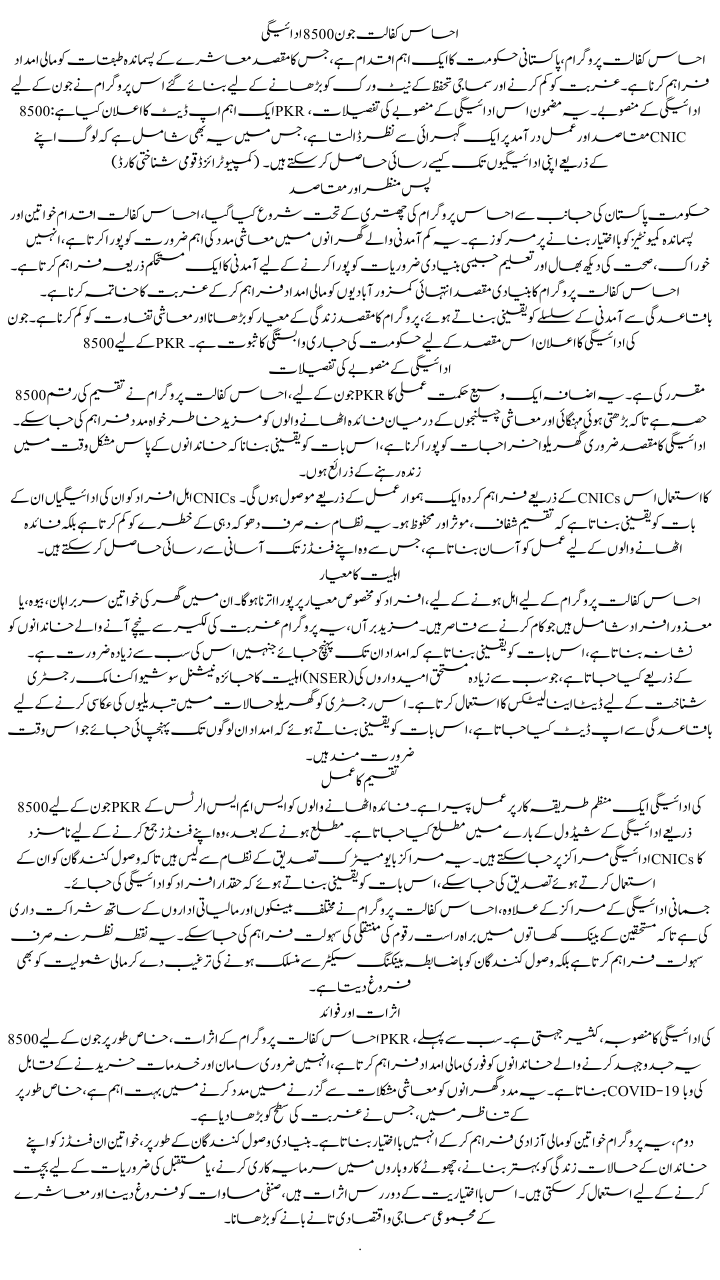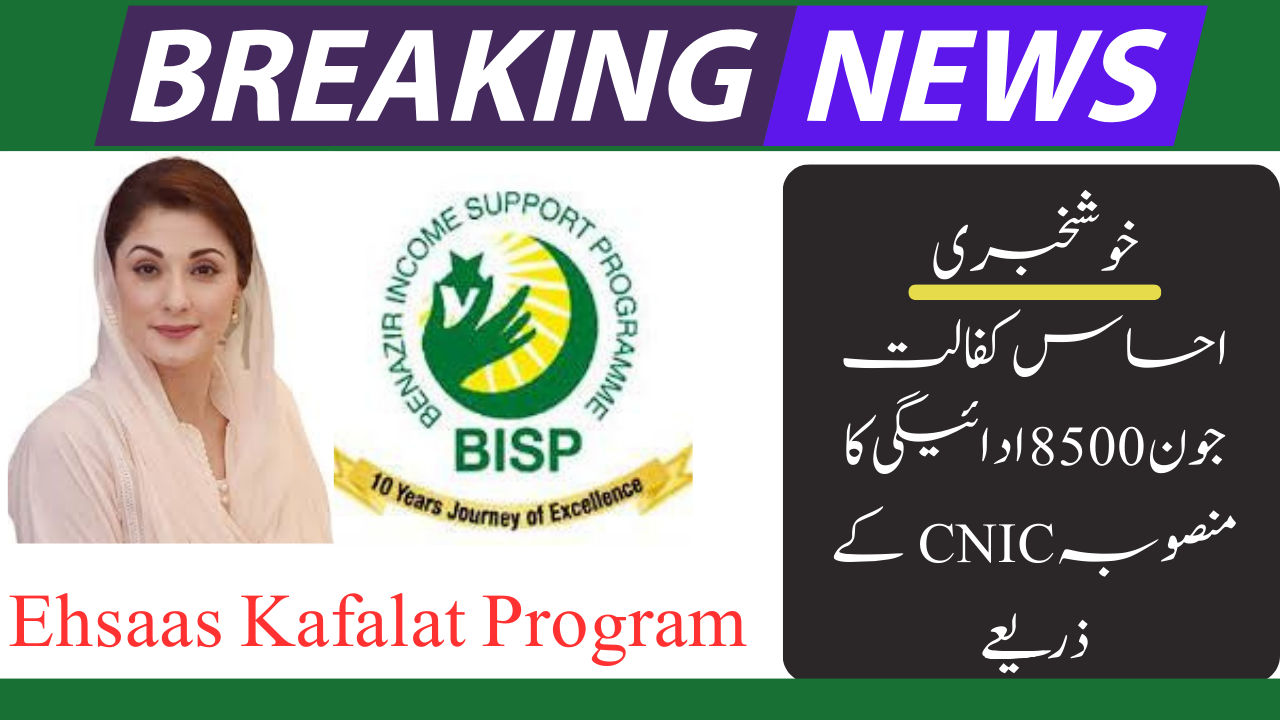Ehsaas Kafalat June 8500 Payment
The Ehsaas Kafalat Program, a key initiative of the Pakistani government, aims to provide financial assistance to underprivileged segments of society. This program, designed to mitigate poverty and enhance social safety nets, has announced a significant update for June: an 8500 PKR payment plan. This article provides an in-depth look at the details, objectives, and implementation of this payment plan, including how individuals can access their payments via their CNIC (Computerized National Identity Card).
Background and Objectives
Launched under the umbrella of the Ehsaas Program by the Government of Pakistan, the Ehsaas Kafalat initiative focuses on empowering women and marginalized communities. It addresses the critical need for economic support in low-income households, providing them with a steady source of income to meet basic needs such as food, healthcare, and education.
The primary objective of the Ehsaas Kafalat Program is to alleviate poverty by offering financial aid to the most vulnerable populations. By ensuring a regular income stream, the program aims to enhance the quality of life and reduce economic disparities. The announcement of the 8500 PKR payment for June is a testament to the government’s ongoing commitment to this cause.
Payment Plan Details
For June, the Ehsaas Kafalat Program has set the disbursement amount at 8500 PKR. This increase is part of a broader strategy to provide more substantial support to beneficiaries amid rising inflation and economic challenges. The payment is intended to cover essential household expenses, ensuring that families have the means to survive during difficult times.
Eligible individuals will receive their payments through a streamlined process facilitated by their CNICs. The use of CNICs ensures that the distribution is transparent, efficient, and secure. This system not only minimizes the risk of fraud but also simplifies the process for beneficiaries, allowing them to access their funds with ease.
Eligibility Criteria
To qualify for the Ehsaas Kafalat Program, individuals must meet specific criteria. These include being female heads of household, widows, or individuals with disabilities who are unable to work. Additionally, the program targets families that fall below the poverty line, ensuring that assistance reaches those who need it most.
The eligibility assessment is conducted through the National Socio-Economic Registry (NSER), which uses data analytics to identify the most deserving candidates. This registry is updated regularly to reflect changes in household circumstances, ensuring that the aid is directed to those who are currently in need.
Disbursement Process
The disbursement of the 8500 PKR payment for June follows a systematic procedure. Beneficiaries are informed about the payment schedule via SMS alerts. Once notified, they can visit designated payment centers to collect their funds. These centers are equipped with biometric verification systems to authenticate recipients using their CNICs, ensuring that the payments are made to the rightful individuals.
In addition to physical payment centers, the Ehsaas Kafalat Program has partnered with various banks and financial institutions to facilitate the transfer of funds directly to beneficiaries’ bank accounts. This approach not only provides convenience but also promotes financial inclusion by encouraging recipients to engage with the formal banking sector.
Impact and Benefits
The impact of the Ehsaas Kafalat Program, particularly the 8500 PKR payment plan for June, is multifaceted. Firstly, it provides immediate financial relief to struggling families, enabling them to purchase essential goods and services. This support is crucial in helping households navigate economic hardships, especially in the wake of the COVID-19 pandemic, which has exacerbated poverty levels.
Secondly, the program empowers women by providing them with financial independence. As primary recipients, women can use these funds to improve their families’ living conditions, invest in small businesses, or save for future needs. This empowerment has far-reaching effects, promoting gender equality and enhancing the overall socio-economic fabric of society.

Furthermore, the Ehsaas Kafalat Program contributes to the broader goal of financial inclusion. By encouraging beneficiaries to utilize banking services, the program helps integrate marginalized populations into the formal economy. This integration not only improves access to financial services but also fosters a culture of savings and investment among low-income households.
Challenges and Future Directions
Despite its successes, the Ehsaas Kafalat Program faces several challenges. One of the primary issues is ensuring that all eligible individuals are accurately identified and included in the NSER database. Continuous monitoring and updating of the registry are essential to maintain its accuracy and relevance.
Another challenge is the logistical aspect of disbursing payments in remote and underserved areas. The government needs to ensure that payment centers are accessible to all beneficiaries, regardless of their geographic location. Expanding digital payment options and mobile banking solutions could address this issue, making it easier for recipients to access their funds.
Looking ahead, the Ehsaas Kafalat Program aims to expand its reach and impact. The government plans to increase the number of beneficiaries and enhance the amount of financial aid provided. Additionally, there is a focus on integrating more comprehensive social safety nets, such as health insurance and educational scholarships, to provide holistic support to vulnerable populations.
Conclusion
The Ehsaas Kafalat June 8500 Payment Plan represents a significant step towards supporting Pakistan’s most vulnerable citizens. By providing financial assistance through a transparent and efficient system, the program aims to alleviate poverty and promote economic stability. As the program evolves, continuous efforts to address challenges and expand its scope will be crucial in achieving its long-term goals of social and economic empowerment.
